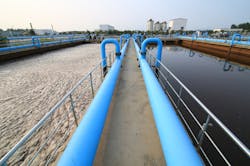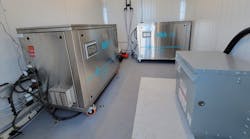Q: What is municipal wastewater treatment’s role in protecting health and the environment?
A: It is essential for the preservation of ambient water quality and the protection of downstream drinking water supplies.
Municipal wastewater treatment facilities are commonly called publicly owned treatment works (POTWs). Other domestic treatment systems, called decentralized plants, include septic tanks and other small and package systems. Municipal wastewater treatment converts highly contaminated sewage into safe, beneficial products and helps maintain the environment at the same time. Technology can convert wastewater into many valuable products ranging from oil biofuels to natural gas, nutrient-rich solids, biosolids for soil conditioning and even high-quality drinking water.
The harmful contamination that must be removed from sewage includes pathogenic microbes, nutrients and chemicals including pharmaceuticals and hormones. Converting the wastewater into safe products is essential before allowing the environment and humans to be exposed to it. The principal human health concern with municipal wastewater will always be pathogenic microorganisms, but environmental consequences of excessive discharges of sewage that has not been adequately treated also exist. They include excessive nutrient loadings that degrade surface waters and potentially harmful pharmaceuticals that can alter the biology of some organisms that live in the water.
What are the major contaminants?
Municipal sewage contains human fecal waste products in addition to whatever people put down drains and chemicals that are discharged by commercial and industrial facilities. Domestic non-human sanitary wastes include soap residues and detritus from clothes washing, showers, bathing, dishwashers, paper and other solids, and metals, as well as inflows from leaking sewer pipes. Cleaning agents, grease and pesticides are sometimes dumped down the drain by consumers as well.
The primary source of pharmaceuticals in sewage by far is therapeutic doses that are ingested, metabolized and eliminated by humans, not direct disposal of unused pharmaceuticals. Commercial and industrial dischargers to municipal sewers are controlled by permits and pretreatment requirements under the federal Clean Water Act implemented by states and localities. Although the regulations are beneficial, they limit some, but not all, chemicals and some quantities of the contaminants.
Microbial contaminants
Pathogenic microorganisms end up in sewage in large quantities not just during disease outbreaks, but also routinely in smaller amounts from people who are not overtly infected. These include bacteria: E. coli, Salmonella and campylobacter; protozoa: Cryptosporidium, Giardia and various amoebae; viruses: hepatitis, 72 types of enteroviruses, norovirus, rotavirus and adenovirus; and other pathogens.
Chemical contaminants
The number of potential chemicals in sewage is almost limitless, but most are present in small quantities. Many natural products from food and source water are present in large amounts measured in milligrams per liter (mg/L) and contribute to the total organic carbon load. Disinfection byproducts from the drinking water and sewage treatment as well as other endogenous chemicals such as nitrosamines can be discharged or generated on-site. Pharmaceutical or metabolic products and human hormones could be present in microgram or nanogram amounts. Industrial chemicals could include solvents, such as acetone, 1,4-dioxane and halogenated hydrocarbons in microgram amounts. Minerals could include calcium, magnesium, iron, copper and others. The greatest concerns arise from chemicals that are not easily chemically converted or biodegradable because they will survive longer in the environment.
Nutrients
The principal nutrients are organic and inorganic nitrogen, and phosphorus. These are components of all foods and also come from life-sustaining cellular and protein metabolism and catabolism. Nitrogenous products can be found in the form of ammonia, amines, nitrate, nitrite or more complex molecules, and the phosphorous contribution will be in some phosphate form.
Sewage treatment
Sewage treatment processes accelerate natural chemical and biological processes that would have occurred in the environment after the sewage is released. The process chemistry, biology and engineering technology is more complex than drinking water treatment because the array of contaminants and other undesirables is so broad. Their concentrations are also greater than that in a contaminated drinking water source. Different combinations and configurations of the following processes are used: solids separation, anerobic and aerobic digestion, ammonia nitrogen conversion, filtration and disinfection.
Wastewater treatment levels are generally categorized as preliminary, primary, advanced primary, secondary, nutrient removal, tertiary, advanced or full advanced (see Table 1, page 10).
Each physical/biological treatment step removes microbial contaminants to a degree. A minimum of secondary treatment is required in all of the more than 16,000 POTWs in the U.S. Universal higher quality wastewater treatment in the country has been introduced over more than 60 years and was ultimately driven by the 1972 amendments to the federal Clean Water Act.
In 1950 about 50 percent of POTWs discharged raw wastewater to the environment, and about 25 percent discharged less than secondary treated wastewater. About 25 percent had received secondary treatment, but none were treated beyond the secondary level. By 2000, no POTWs discharged raw wastewater, 57 percent provided secondary treatment, 30 percent treated beyond secondary and 12 percent achieved no discharge of treated effluent to surface waters. Only a fraction of a percent (47 out of 16,033) had less than secondary treatment.
Full advanced treatment, which is more extensive than the other levels, can be applied when the product water is intended for potable reuse. Its membrane separation process follows secondary or tertiary treatment, and then reverse osmosis removes almost all residual organic and inorganic chemicals, as well as microorganisms. From there an advanced oxidation process generates hydroxyl radicals to decompose any residual trace organic chemicals to sub parts-per-billion levels.
Disinfection can be applied at multiple stages to control septic odors, kill microorganisms or provide oxidative effects. The effects could include colloid conversion to improve settling rate and removal by filtration. Common disinfectants include a form of chlorine (about 70 percent), ozone or ultraviolet light (about 21 percent), and sometimes more than one disinfectant is used in treatment. The ammonia nitrogen content of wastewater is substantial, so chlorine disinfection will usually not reach breakpoint, at which the ammonia nitrogen would be oxidized and leave a free chlorine residual. The effluent will usually contain chloramines. If the receiving water is at risk because of low volume relative to the treated effluent, sensitive ecosystem, or inadequate mixing, many chlorinated effluents are dechlorinated with a reducing agent to lower their toxicity to aquatic life.
Membrane bioreactors (MBR), a newer method, use a reaction chamber with a semipermeable membrane that combines biological treatment with membrane separation. The system pairs microbial activity that reduces pathogens with organic chemical content with membrane filtration. MBRs replace conventional coagulation, sedimentation and filtration, and produce a higher quality effluent with a smaller footprint for the treatment facility at lower cost (see Table 2).
Effluent water quality
Significant water quality improvement is achieved depending on the selection of technologies. Here are a few examples from Water Reuse, Metcalf and Eddy, 2006.
Energy consumption
Typical energy requirements per 1,000 gallons range from about 1.38 kilowatt-hours (kwh) for secondary treatment without nutrient removal, to 1.84 kwh for tertiary treatment with nutrient removal and filtration, compared to 3.31 kwh for advanced potable reuse, to 11.97 kwh for ocean water desalination.
Decentralized systems
Decentralized systems that include septic tanks, "package" and on-site and clustered wastewater treatment systems are used in 25 percent of U.S. homes and 33 percent of new developments. They are not POTWs and the U.S. Environmental Protection Agency (EPA) is concerned that many are mismanaged. The EPA has issued Voluntary National Guidelines for Management of Onsite and Clustered (Decentralized) Wastewater Treatment Systems, hoping to improve their performance.
Conclusions
Wastewater treatment plays an essential role to protect public health and the environment. No longer considered a liability to be treated and disposed of, wastewater is now considered a beneficial asset to be exploited. Wastewater is ideal for recycling because a collection system delivers sewage to POTWs to be processed. POTW operation is a complex enterprise because of the broad range and concentrations of the contaminants that must be managed. Biological processes in particular require careful management because of bacteria’s sensitivities to variation in temperature, composition, pH and other factors that affect their composition, viability and activity.
Multiple technologies and configurations are available and in use, and research continues to improve the processes and reduce unit costs. The selection of the treatment train is partly a function of the composition of the sewage, the desired end product and costs. Even so, the relative and absolute costs demonstrate that wastewater treatment is affordable in the U.S., and opportunities remain to extract desirable products from wastewater in POTWs. Concerns about the performance of decentralized systems seem to provide a business opportunity for small equipment suppliers and service providers.
Dr. Joe Cotruvo is president of Joseph Cotruvo and Associates, LLC, Water, Environment and Public Health Consultants. He is a former director of the EPA Drinking Water Standards Division.


